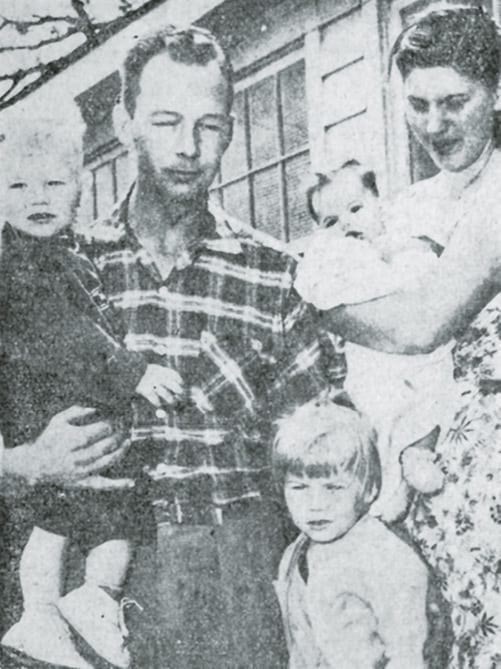Incident that killed Navy pilot all but forgotten 61 years later
BY JOHN CHICK Special to the VOICE
Sixty-one years and one month ago, fire came from the sky just east of Fonthill.
May 25, 1958 was a much different time. The Town of Pelham hadn’t been formed yet, and was instead a collection of hamlets including Fonthill, Fenwick, Ridgeville, North Pelham and Effingham. Internationally, the Cold War was heating up. The DEW line—a series of radar stations in the Canadian north designed to detect Soviet nuclear bombers —had been activated a year earlier. The Avro Arrow, Canada’s attempt at a supersonic jet fighter plane, was in the testing phase and was still a year away from being controversially cancelled.
 Back here, the Sunday morning quiet on Victoria Day weekend was shattered when a Royal Canadian Navy single-engine Grumman Avenger torpedo bomber slammed into the ground in a ball of flames at a property on Highway 20 between Rice and Cataract Roads—near what is now the new Minor Bros. store at the Pelham-Thorold boundary.
Back here, the Sunday morning quiet on Victoria Day weekend was shattered when a Royal Canadian Navy single-engine Grumman Avenger torpedo bomber slammed into the ground in a ball of flames at a property on Highway 20 between Rice and Cataract Roads—near what is now the new Minor Bros. store at the Pelham-Thorold boundary.
The crash instantly killed the Naval Reserve pilot, Sub.-Lt. W.A.K. Chambers. The 25-year-old was flying a routine training run out of Downsview Airport in Toronto. Parts of his body were found in an orchard a half-mile away.
Mere feet from the crash site was the home of Lloyd Burton, his wife Dorothy, and their three children—Marie, then age three, Arthur, one, and Betty, three months.
Despite their close proximity to the horror, they all escaped with their lives, unhurt.
“It all happened so quickly,” Lloyd Burton was quoted as saying in the next day’s issue of the The Evening Tribune newspaper.
 “The plane was only 100 yards away when we got out on the porch,” Burton said, via the same day’s Globe and Mail. “I carried [the two younger children] outside to see it,” he was quoted in the Toronto Star. “We thought the pilot was stunting.”
“The plane was only 100 yards away when we got out on the porch,” Burton said, via the same day’s Globe and Mail. “I carried [the two younger children] outside to see it,” he was quoted in the Toronto Star. “We thought the pilot was stunting.”
But then, disaster struck.
“It was coming directly toward our yard in a tight bank with the cockpit toward the house … I could not estimate the speed,” Burton said. “The right wing tip hit the ground, throwing the plane on its nose. It dug a hole about six feet deep where part of the engine and propeller fell off. Everything was shaking and smoke was all over.”
If Burton’s description of the plane’s doomed spiral sounded technical, it was because, according to The Evening Tribune, he was a civilian pilot himself, with 100 flight hours.
The theme of aviation in general seems omnipresent from that terrible day.
According to the Star, another witness to the tragedy was legendary Pelham aviator Dorothy Rungeling, a later recipient of the Order of Canada and namesake of Pelham’s airport, where just last weekend she was again celebrated as an international women’s air race came to its conclusion.
The Star reported that Rungeling saw wisps of smoke come out from behind the plane minutes before the crash.

The impact of the aircraft hitting the ground was felt as far east as Port Robinson, with the plane’s wheels coming to rest a mile away at Turners Corners.
Without social media or even regular television news at the time, the story of the catastrophe traveled the old-fashioned way—by word of mouth, and in print the following day.
“Family of Five Watches Plane in Death Dive,” rhymed the headline in the Globe and Mail. “Will Never Forget Scene of Crash!” read another from The Evening Tribune, with perhaps an unnecessary, Elaine Benes-like exclamation point.
In that story, writer Margaret Deitsch described “a roar of plane” zooming over her house and, soon after, the wail of Fonthill’s volunteer firefighter horn.
“Jumping into a car we followed in the direction we thought the plane crashed,” she wrote. “Within 10 minutes we witnessed the scene three miles away. It was a picture of devastation. Crowds stood in amazement, some expressing their own versions of the crash, while others stood by in absolute disbelief … a member of the Fonthill Fire Department stated it was a Navy plane and it was believed that only one man was aboard. Asked if any residents of the area were injured, he replied, ‘No, only the pilot, but the Burton family came mighty close.”
Miraculously, the only damage to the Burton home was two broken windows, and pieces of the aircraft embedded in the walls and porch.
“It was a terrifying experience,” the Star reported Dorothy Burton as saying.
“Roads within six miles of the scene were packed as Sunday drivers and curiosity seekers swarmed to the crash scene,” the article read. “The press of traffic was finally brought under control by police and firemen working together.”
Dorothy Burton, now believed to be in her 90s and still living in the area, declined a Voice request to be interviewed for this story.
Today, no evidence remains of the crash. While a handful of farmhouses still sit on this stretch of Highway 20, the strip is now dominated by businesses. Up in Toronto, Downsview Airport is no longer a military base but rather a testing facility for Bombardier, surrounded by homes, the practice fields for the Toronto FC soccer team, multiple strip plazas, and two subway stations.
Time marches on. But don’t believe there’s never been a major news event in Fonthill.


